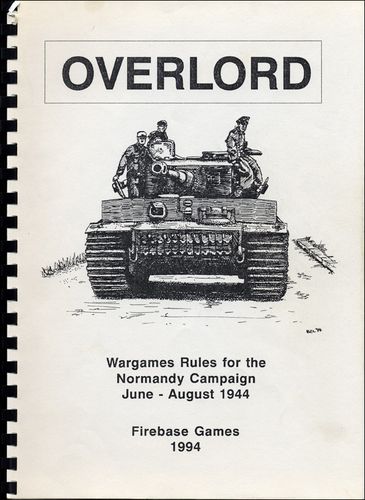|
Advertisement
|
Overlord: Wargame Rules for the Normandy Campaign – June-August 1944

DescriptionOverlord is a set of miniature wargame rules that cover tactical-level combat in Normandy from June to August, 1944. The rules are suitable for 1:300th to 28mm scale, though they work best for 15mm miniatures. The ground scale for the game is 1" equals 10 metres, 1 turn equals 2 1/2 minutes, 1 model soldier/vehicle equals 1 real soldier/vehicle. The basic unit for the game is an infantry squad or individual gun and crew or single AFV. Infantry are mounted in multiples on bases that represent rifle groups, light machine gun groups, heavy machine gun groups, light mortar groups. etc. Leaders, who represent platoon leaders and senior NCOs, are mounted singly. The sequence of play follows traditional lines: Initiative, Move, Fire, Close Assault, Morale. However, there is a Watch and Shoot phase, where units can elect to fire before the normal Fire phase or hold their fire to take opportunity fire against the opponent's moving units. Only units with Watch and Shoot orders can take opportunity fire. Firing is done by individual stands; there is no mechanism for combining the fire of several stands, though the results of fire combat can have a cumulative effect. Fire combat uses a unique system where a firing stand's weapon type is first cross-referenced with one of six major columns that represent the cover state of the target unit(s), then cross-referenced with the result of a modified die roll. Results can create individual casualties for a stand or, in a separate die roll, the loss of the entire stand. Because casualties represent the loss of single soldiers, a stand may take several casualties before it is lost. Before units can be targeted for fire, they must be spotted. The visibility of units can be affected by activities such as moving, firing, etc. Units might be very difficult to spot, which represents the historical difficulty of seeing the enemy in the dense terrain of Normandy. In larger games, keeping track of which units are spotted may be cumbersome. Morale is strictly based on the performance of historical units. There is a special category called Fanatic that is used solely by units of the 12th SS "Hitlerjugend" division. This represents the relative inexperience of the troops combined with the fanaticism instilled in them through their Hitler Youth indoctrination. Most Allied units are classed as Inexperienced, which represents the fact that, though well-trained, they are experiencing combat for the first time. Other Classifications are Elite (such as Airborne units and most of the SS), Veteran (most German units), and Poor (such as German Ostbattalion units). The antitank rules are fairly simply, but they tend to provide predictable historical results. The rules don't really seem to emphasize tank combat. Rather, tanks are added in as a specialized heavy weapon, but the rules are not intended for large tank vs. tank actions. The game play allows for hidden set up and limited hidden movement, which can give the defender (usually the Germans) the ability to mount a very tenacious defense while being strongly outnumbered. Overlord can be used to play games that consist of only a few squads or up to a full battalion on each side. However, larger games can be slow. Many of the mechanics for Overlord are similar to the mechanics used in the designer's other WW2 tactical rules, "Grey Storm, Red Steel." Game DiscussionsAdd CommentYou need to be logged in to comment. Insert Bullet List Please enter at least one item. Item: Item: Item: Item: Item: Insert Numeric List Please enter at least one item. Item: Item: Item: Item: Item: Insert Link Please enter the link of the website Optionally you can add display text Insert Email Please enter the email address Optionally add any display text Insert Image Please enter the link of the image Insert YouTube Video Please enter the link of the video Marketplace | ||||

Comments (0)